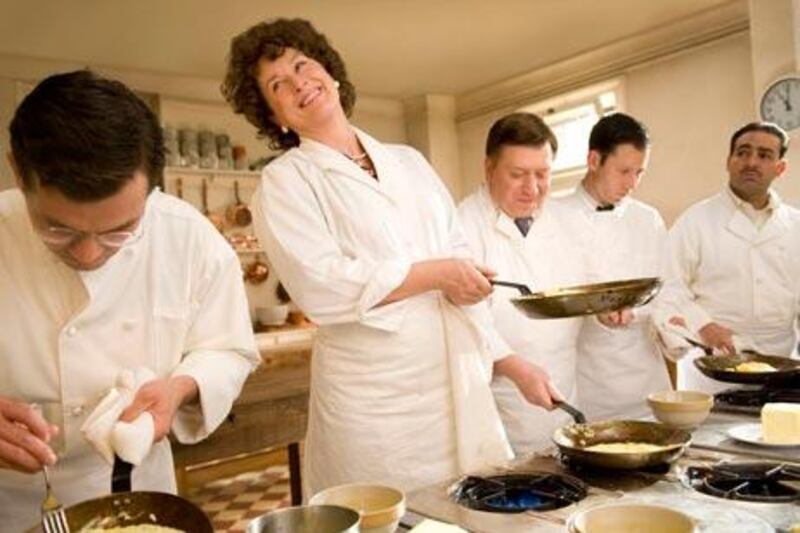They gave us frogs' legs, snails and foie gras. They also gave us meticulously organised kitchens, haute cuisine and the concept of the restaurant as we know it. Whatever you might think of French cooking, it has had an undeniable influence on gastronomy at every level. And the cuisine still has the ability to captivate us with its rich folklore and legends to this day. Such as the story about the tall American woman whose head was turned by a sole meunière on a maiden visit to the French city of Rouen in 1948. Her name was Julia Child and she was later to describe the event as "the most exciting meal of my life".
Child went on to become a chef, an author of cookery books and a television presenter, and she is widely regarded as the woman who brought French cuisine to a mainstream audience in the US. The tale of how she went from being an advertising copywriter, a civil servant and the wife of a US envoy, to becoming an authority on French cooking in America is told in the film Julie & Julia, starring Meryl Streep, which hits cinema screens in the UAE this week. The autobiography that helped to inspire the film, My Life In France, was compiled towards the end of Child's life, and has been rereleased to coincide with it.
That it follows hot on the heels of an updated English translation of one of France's most popular cookery books is testament to our enduring fascination with French cuisine. Je Sais Cuisiner by Ginette Mathiot has already sold six million copies, but now it's being repackaged as I Know How To Cook, and marketed as the authority on home cooking. And as Etienne Haro, the restaurant director at Reflets par Pierre Gagnaire restaurant in Dubai tells me, like French food in general it's not surprising that its appeal will go far and wide.
"It's a book that everybody has in my family," he tells me. "In fact, in France everybody has it. If you like to cook, you have Ginette Mathiot. I have two. I have an old first edition, and I have a new one that's more handy to use. It's so well structured and so well thought out, that the classic recipes from Ginette Mathiot are possible for me - you can be a great French cook with it. You can pretend you didn't look at the book."
According to Haro, the tradition of the French cookery book as a vital reference is still alive and well, for both seasoned chefs and amateur cooks. "Regardless of your level of cooking, it's a book that you should have," he says with matter-of-fact certainty. "In professional kitchens, you'll often have a copy of Escoffier," he remarks, referring to Le Guide Culinaire, the masterwork of the French chef Auguste Escoffier, which is widely regarded as the blueprint for modern European haute cuisine. Published in 1903, it has more than 5,000 recipes, and chapters on everything from sauces and savouries, to oeufs and hors d'oeuvres.
"It will be a point of reference even for Michelin-star chefs," Haro continues. "Sometimes we will look in there to see a classic recipe. Now, given the size of Escoffier and the complication of some preparations, it's not something for the household. I think what Mathiot did very cleverly is create the household, easy-to-understand version of that reference book and that's why it works so well. "Perhaps these kind of books are part of the current trend of looking back at traditions, looking into the respect of the products and their origins. Wherever you go, people are using more local and regional ingredients. That's what the book is all about, it's all about regional cooking - the region is actually indicated against the recipes. So I think it's good that it's come back in fashion. "
So what is more important about French cuisine, its well-documented theories and philosophies or its actual produce? I decided to ask somebody who would know - an Englishman called Matt Pickop, who also happens to be the executive chef at Verre by Gordon Ramsay in Dubai. Having worked and trained with legendary French chefs such as Albert Roux, Guy Savoy and Joël Robuchon, Ramsay brings an unmistakably French twist to his restaurants. But according to Pickop, it's all down to the raw materials.
"The ingredients the French use in a lot of their cookery are good basic ingredients," he says. "The tomatoes and the garden ingredients, the home-baked breads. Those are the things that you go to France for - you go and pick up your fresh breads from the boulangerie, and then you go to the charcuterie for your meat. And then there's the cheese. It's all fresh daily produce, so that's one of the things that the French have brought to England and most of Europe."
He goes on the enthuse about fresh French bread. "There's nothing better for me," he says. "That's the basic of any meal, to have a really hearty bread to eat before your meal. No matter how good the meal is, there's always one thing that I remember, and that's the bread. "If it's stale, not fresh or not hot, then it always stays in the mind. You could have had the best meal in the world, but when that bread's not perfect it's always what you remember."
Gilles Perrin, the executive sous chef at Bord Eau French restaurant in Abu Dhabi, agrees. "I think it's more about the products than the food itself," he admits. "Ninety-nine per cent of any produce you can get is there - fish from the Mediterranean, oysters from Brittany, cheese, beef, almost anything. The producers are proud of what they have - maybe more than anybody else. They don't sell for the sake of selling it. For example, the chief supplier we use at Bord Eau will never go for high volume because he's proud of his product and he wants to keep it as it is."
Yet whatever rare and wholesome delights can be found among regional French ingredients, Perrin still reveres the French restaurant as an institution that has revolutionised the way we regard dining. "I think it's more about the table, the service, the presentation, the maître d'," he says. "There's an influence when we talk about the basics of cooking the sauces, roasting, grilling or things like this, but I think it's more about the restaurants, the ambience and the whole package of French eating out."
We talk about the importance of French history in the rise of the restaurant, about how the French Revolution of 1789 spelt the end of the catering guilds and caused the aristocracy to abandon their homes, servants and cooks. "Chefs would be cooking for the royal family, but not cooking for the people until after the French Revolution," he says. "This is where the restaurant really starts. All the chefs and the maîtres d' from the royal households would open restaurants." Then, roughly 100 years later, along came Auguste Escoffier to draw up a ruthlessly researched and highly organised guide to how a professional restaurant should be run.
"Escoffier said: 'This is how we do it, this is how it's supposed to be done.' People are following that in Europe, in Russia, in Abu Dhabi or in Tokyo," says Perrin. "But to say that French food itself has revolutionised world food, I'm not really sure. It brings something different, but you can say the same thing about Chinese, Arabic, Turkish or Japanese cuisine. Especially nowadays." As far as Etienne Haro is concerned, it was Escoffier's influence in drawing up a step-by-step guide to the French restaurant that made all the difference. "I think the success lies in the codification," he suggests. "With Escoffier, you had the codification, which helps to spread something because it gives a set of rules."
Another chef who can vouch for the Escoffier model is Matt Pickop. "My kitchen is split up into sections and everybody has a certain job, and it's just a way of great organisation," he says. "Getting the service down to a T is essential, and that comes down to timing and organisation." "But French cooking has always been at the forefront of training and learning," he continues. "You've got Le Cordon Bleu, which is the very classic gastronomic style of cooking. Nowadays what we do is try to bring those classics back to life. It's about learning the classics - individual things like sauces and the preparation of the produce. It all has that classic French twist to it."
If any movement in cooking can be said to have put the life back into the old classics, it's nouvelle cuisine. As Haro explains: "A lot of French influence comes from the mid to late 20th century, from names who are still today at the top of their game - like Paul Bocuse and Michel Guérard. I was in France and there was a four-page spread in a magazine about Michel Guérard. That guy revolutionised one side of cooking in France in the Sixties. So, their influence is still very strong. That group of, say, 10 chefs that invented nouvelle cuisine, they really managed to spread the word of an idea of French cooking that was easier to do, simpler and lighter. It was a massive revolution."
But where Haro sees the positive influence of nouvelle cuisine, Perrin accepts that there's also a downside. "People always see French food as expensive, and with small portions. Maybe that's because when chefs like Michel Guérard and Paul Bocuse came out with the nouvelle cuisine, the portions were smaller. However, they were the first ones really to travel around the world, to Japan and the US."
Matt Pickop concedes that the misconception of French food as stuffy or pretentious can also be a problem. "It comes down to the old classic snobbery of going to a fine-dining French restaurant. You don't really hear anybody saying they're going to a fine-dining Japanese restaurant. People go to Zuma and it's an evening of entertainment and great food, something totally different. But the idea of going to a French restaurant is like, we must wear a shirt and tie. And that's not the case at all. At Verre we don't have that kind of thing, but we still have really good service. That's the French style - the idea of service."
Whatever misconceptions still exist about French cuisine, the latest popular film and book releases inspired by Julia Child and Ginette Mathiot will hopefully serve to change them. And, who knows, it may very well lead to the most exciting meal of your life.






